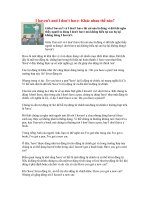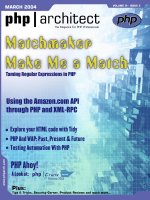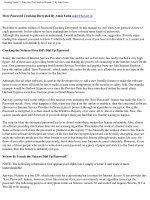Don't Make Me Think
Bạn đang xem bản rút gọn của tài liệu. Xem và tải ngay bản đầy đủ của tài liệu tại đây (1.42 MB, 22 trang )
Melinda Hileman
Owner of Hileman Holdings, LLC
1
Hi, my name is Melinda Hileman, the owner of Hileman Holdings, the parent company of
Hileman Design and Grounding Stones Jewelry.
Hileman Design provides graphic design, web design, desktop publishing and public relations
services, and with Grounding Stones Jewelry, I make and sell wire-wrapped stone jewelry.
2
Steve is a usability consultant with more than 20 years of experience as a user advocate for
companies like Apple, Netscape, AOL and others.
He has become a highly sought-after speaker on usability design since the first version of
this book came out.
“What’s the most important thing I should do if I
want to make sure my Web site is easy to use?”
Nothing important should ever be more than
two clicks away?
Speak the user’s language?
Be consistent?
3
Krug’s First Law of Usability
DON’T MAKE ME THINK!
Self-evident, obvious and self-explanatory
The user should be able to “get it”
4
Krug’s First Law of Usability is Don’t Make Me Think. If you only have room in your head for
one usability rule, make it this one!
Your pages should be self-evident, obvious and self explanatory.
The user should be able to “get it” - what your page is and how to use it - without expending
any e!ort thinking about it.
5
In the first example, as the user visits the page, he has a lot of questions.
But in the second example, there are no questions - the user is able to easily digest the page
and find the content they’re looking for.
So, when you’re creating a site, it’s your job to get rid of the question marks.
Things That Make Us Think
6
A lot of things on a Web page can make users stop and think unnecessarily, like names of
things, and links and buttons that aren’t obviously clickable. As a rule, people don’t like to
puzzle over how to do things. The fact that the people who built the site didn’t care to make
things obvious - and easy - can erode a user’s confidence in the site and its publishers.
So you can see in this first example, simple wording can help users find what they are looking
for quickly. In the second example, making links obviously clickable is also important. Ways
to do this would be to use conventions such as buttons or blue underlined text.
What shouldn’t visitors
have to think about?
Where am I?
Where should I begin?
Where did they put ___?
What are the most important things on this page?
Why did they call it that?
7
The last thing you need is another checklist to add to your stack of Web design checklists.
The most important thing you can do is to just understand the basic principle of eliminating
question marks.
If you do, you’ll begin to notice all the things that make you think while you’re using the
Web, and eventually you’ll learn to recognize and avoid them in the pages you’re building.
How we really use the Web
Scanning, satisficing, and muddling through
We create sites as though people are going to
pore over each page and weigh their options
before deciding which link to click
What they actually do most of the time (if we’re
lucky) is glance at each new page, scan some of
the text and click on the first link that catches
their interest or vaguely resembles the thing
they’re looking for
8
When we’re designing pages, we tend to assume that users will scan the page, consider all of
the available options, and choose the best one.
In reality though, most of the time users don’t choose the best option - they choose the first
reasonable option, a strategy known as satisficing; a cross between satisfying and su"cing.
As the children’s riddle goes; “Why are things always in the last place you look for them?
Because you stop looking when you find them.”









